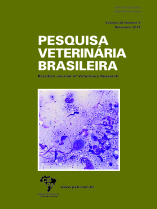 |
|
|
|
Year 2018 - Volume 38, Number 9
|

|
Post mortem evaluation of spinal cord and protruded intervertebral discs in dogs without neurological abnormalities, 38(9):1793-1799
|
ABSTRACT.- Zani C.C., Marinho P.V.T., Diamante G.A.C., Sueiro F.A.R. & Bahr Arias M.V. 2018. Post mortem evaluation of spinal cord and protruded intervertebral discs in dogs without neurological abnormalities. [Avaliação post mortem da medula espinhal e de discos intervertebrais protrusos em cães sem alterações neurológicas.] Pesquisa Veterinária Brasileira 38(9):1793-1799. Departamento de Clínicas Veterinárias, Universidade Estadual de Londrina, Rodovia Celso Garcia Cid Km 380, Londrina, PR 86057-970, Brazil. E-mail: vicky@uel.br
The aim of this study was to verify the presence of protrusion of the intervertebral disc (IVD) causing compression of the spinal cord and/or roots of cauda equina in 30 dogs above seven years of age with no evidence of previous neurological abnormalities. After the occurrence of death or euthanasia, a laminectomy was performed from C2 to the sacral vertebra to verify the presence of IVD protrusions. The protruded IVD were macroscopically graded according to the Thompson scale, and the corresponding spinal cord segment was histologically analyzed for nervous tissue compression. Of the 30 dogs, twelve (40%) presented disc protrusion, and of these 12 dogs, seven (58%) presented more than one protruded disc. Disc protrusion was observed in 3.2% (25/780) of all IVD evaluated. Of the six chondrodystrophic dogs, five (83%) presented disc protrusion. Of the 24 nonchondrodystrophic dogs, seven (29%) presented IVD protrusion. The site that showed the highest frequency of protrusion was L4-L5 (6/25) followed by the L6-L7 region (3/25) and C6-C7 (3/25). Only two of the medullary segments evaluated showed histological changes, with presence of focal lymphocytic infiltration and multifocal mild hemorrhage in the gray matter. Under the conditions of this study, 40% of dogs older than seven years old showed IVD protrusions without showing neurological signs, with no abnormality of the nervous tissue in 92% of the evaluated segments. Thus, the protrusion of the IVD in some dogs, can only be a finding of no clinical relevance. |
| |
|
|
| |
|
 |